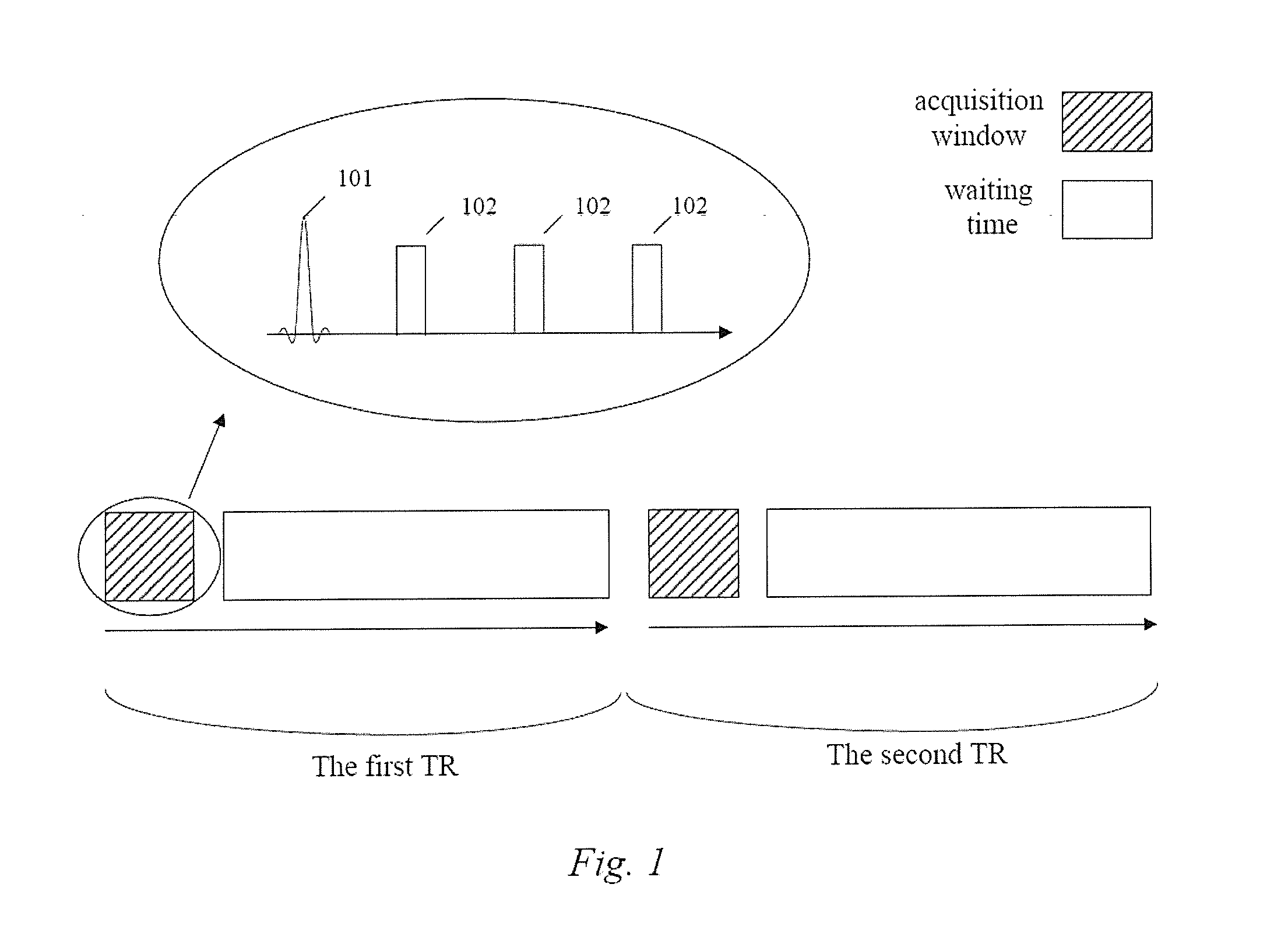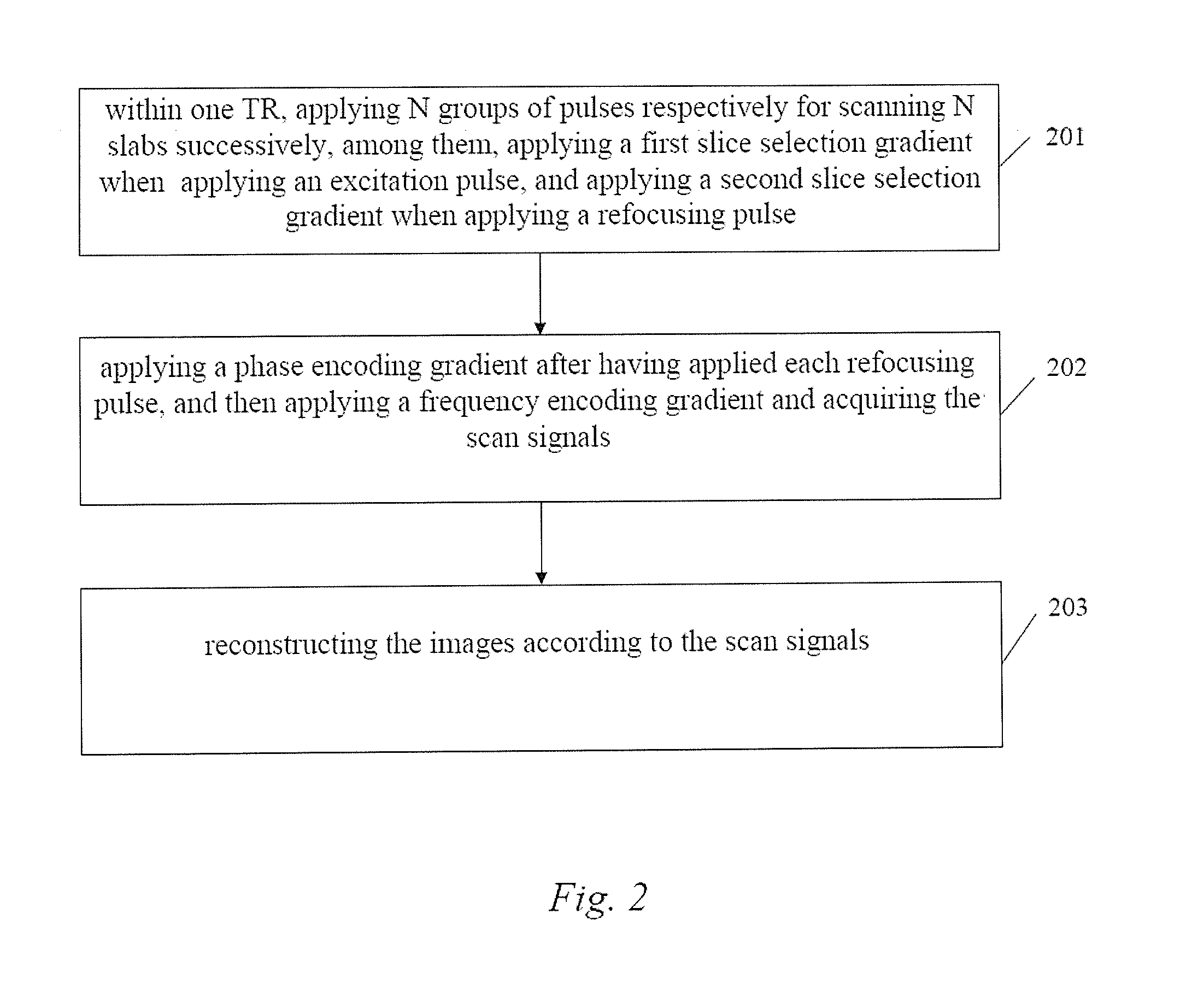Method for three-dimensional turbo spin echo imaging
a three-dimensional, echo imaging technology, applied in the field of magnetic resonance imaging, can solve problems such as reducing imaging efficiency, and achieve the effects of improving imaging efficiency, shortening imaging time, and improving imaging efficiency
- Summary
- Abstract
- Description
- Claims
- Application Information
AI Technical Summary
Benefits of technology
Problems solved by technology
Method used
Image
Examples
first embodiment
The First Embodiment
FIG. 2 is a flowchart of the first embodiment of a 3D-TSE imaging method provided by the present invention. As shown in FIG. 2, the method comprises the following steps:
Step 201: within a TR, the magnetic resonance imaging system applies N groups of pulses for respectively scanning N slabs in succession, with each group including one excitation pulse and more than one refocusing pulse, and it applies a first slice selection gradient at the same time as applying each said excitation pulse, and applies a second slice selection gradient at the same time as applying each said refocusing pulse, wherein N is a positive integer greater than 1.
Step 202, the magnetic resonance imaging system applies a phase encoding gradient after having applied each refocusing pulse, then applies a frequency encoding gradient, and acquires the scan signals during the duration of the frequency encoding gradient.
Step 203, the magnetic resonance imaging system reconstructs images according ...
second embodiment
The Second Embodiment
The first embodiment achieves the object of improving imaging efficiency, but the image quality can be further optimized on the basis of the improvement of imaging efficiency, and the second embodiment will be described in detail below.
There are four points to be illustrated. First, as noted in the above description, a selective excitation pulse means applying excitation pulse and slice selection gradient to the examined tissues simultaneously, thus making the excitation pulse be selective, and a selective refocusing pulse means applying the refocusing pulse and slice selection gradient to the examined tissues simultaneously, thus making the refocusing pulse be selective. In the present invention the slice selection gradient matching the excitation pulse is designated as the first slice selection gradient, and the slice selection gradient matching the refocusing pulse is designated as the second slice selection gradient. It can be seen that in the same group of ...
third embodiment
The Third Embodiment
The second embodiment achieves the object of improving imaging efficiency and eliminating the sideband artifacts of the slab, but the image quality can be further optimized on the basis of the first embodiment and the second embodiment, and the third embodiment will be further described in detail below.
In practical applications, since the selectivity of excitation pulses or refocusing pulses is not ideal. Alternatively, since the inconsistency between the frequency of radio frequency pulses and the resonance frequency of the protons leads to the drift of the region of the excited protons compared with an ideal case, which finally reflects in the scan image and affects the strength and contrast of the scan signals to a certain extent. FIG. 7 is a schematic diagram of the strength and / or contrast of the scan signals. As shown in FIG. 7, the slab is divided into five regions by the straight lines L1, L2, L3, and L4 along the slice selection direction, in which the f...
PUM
 Login to View More
Login to View More Abstract
Description
Claims
Application Information
 Login to View More
Login to View More - R&D
- Intellectual Property
- Life Sciences
- Materials
- Tech Scout
- Unparalleled Data Quality
- Higher Quality Content
- 60% Fewer Hallucinations
Browse by: Latest US Patents, China's latest patents, Technical Efficacy Thesaurus, Application Domain, Technology Topic, Popular Technical Reports.
© 2025 PatSnap. All rights reserved.Legal|Privacy policy|Modern Slavery Act Transparency Statement|Sitemap|About US| Contact US: help@patsnap.com



